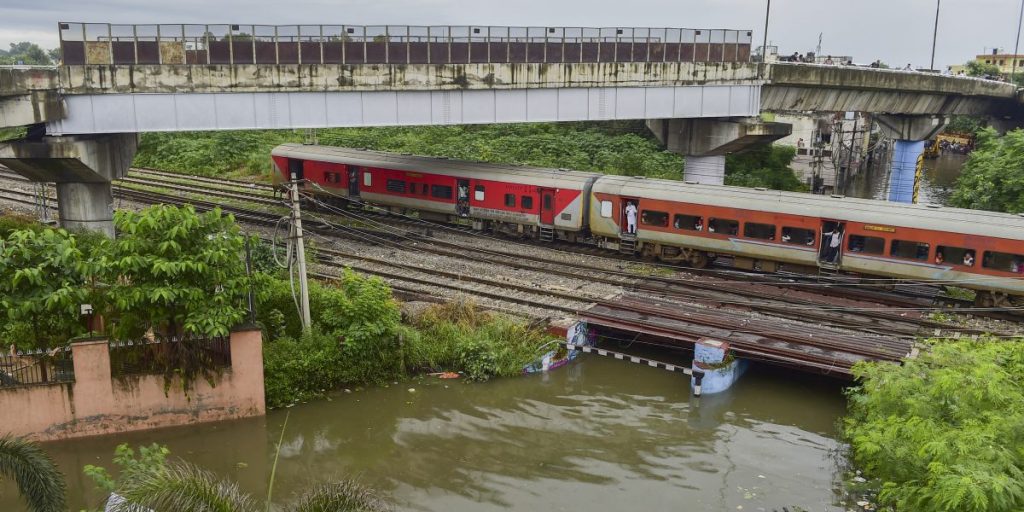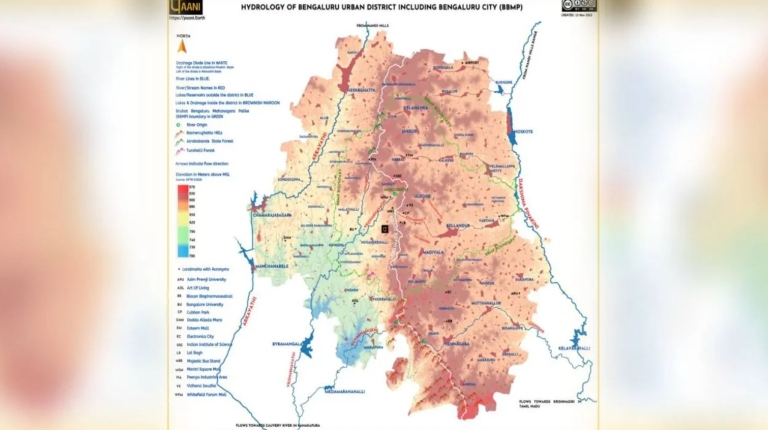Like Punjab, the Himachal government has also declared its state flood hit. Together, the states have lost close to 350 people.
Chandigarh: Struck by what is being said to have been its heaviest rainfall in the last 25 years, Punjab has been devastated by floods caused due to all its rivers overflowing, prompting the Aam Aadmi Party-led government to declare the entire state flood-hit.
The continued inflow of water from the Bhakra Dam on Sutlej river and the Pong dam reservoir on the Beas river, which remains near the danger mark due to heavy rainfall in its catchment area, has further aggravated the flood situation in Punjab.
As rains remain incessant, almost 65,000 cusecs of water were released down stream from the Bhakra dam on Wednesday, September 3, almost three times more than the average release, officials said.
Similarly, the Pong dam reservoir on Beas released 79,000 cusecs of water downstream against 16,000 cusecs of water released the same day last year.
Like Punjab, the Himachal government has also declared its state flood hit after 310 deaths and financial losses touching to almost Rs 3000 crore.
Both Punjab and Himachal Pradesh governments – ruled by opposition parties – have appealed to the BJP-led Union government for a special relief package to deal with the prevailing crisis.
In his post on X today, September 3, Congress leader Rahul Gandhi too urged Prime Minister Narendra Modi to announce a special relief package for flood-hit Punjab, Jammu and Kashmir, Uttarakhand and Himachal Pradesh, and to step up rescue operations.
 People walk along the bridge over the swollen Beas river amid rainfall, in Kullu district, Himachal Pradesh, Tuesday, Sept. 2, 2025. Photo: PTI.
People walk along the bridge over the swollen Beas river amid rainfall, in Kullu district, Himachal Pradesh, Tuesday, Sept. 2, 2025. Photo: PTI.
1400 villages inundated, 30 lives lost in Punjab
While Punjab demanded Rs 60,000 crore from the Union government, the floods so far have claimed 30 lives and left more than 3.54 lakh people affected across the state, in addition to damaging 1.48 lakh hectares of standing crops, revealed official communication from the Punjab government on September 2.
The north-east and north-west districts of Punjab, including Gurdaspur, Pathankot, Amritsar, and Tarn Taran – collectively known as the Majha region – are among the worst affected, along with central districts in the Doaba region such as Hoshiarpur, Jalandhar and Kapurthala.

In this screengrab from a video posted on Aug. 28, 2025, stranded people being evacuated through an army helicopter from a flood-affected area, in Gurdaspur, Punjab. (@adgpi/X via PTI Photo)
In contrast, conditions remain comparatively stable in Punjab’s largest southern belt, Malwa but the entire region continues to be on high alert.
Due to the floods, a total of 1400 villages have been inundated with Gurdaspur having the highest, 324 villages, followed by 135 villages in Amritsar, 119 villages in Hoshiarpur, 115 villages in Kapurthala and 108 in Mansa.
Union agriculture minister Shivraj Chouhan will visit Punjab’s flood affected areas on September 4 to take stock of the situation.
Heavy rainfalls breaking past records
In August, Punjab, with 74% excess rainfall recorded its highest rainfall in 25 years, while Himachal Pradesh, with 68% surplus rain, experienced its wettest August in 76 years.
Officials attributed the heavy to very heavy rainfall across Himalayan towns as well as the plains of Punjab to changing weather patterns.

In this image posted on Aug. 30, 2025, members of Aam Aadmi Party (AAP) during a visit to a flood-affected area in Punjab. Photo: @AAPPunjab/X via PTI Photo.
Senior scientists at the Himachal Pradesh Meteorological Department as well as the Chandigarh Meteorological Centre confirmed that western disturbances – originating from the Mediterranean and Caspian seas, responsible for winter rainfall in northern India and usually subsiding by April – remain active to this date, alongside the summer monsoon.
Sandeep Kumar Sharma, a Shimla based meteorological scientist, told The Wire that Himachal has been witnessing heavy to very heavy rainfall due to both western disturbances as well summer monsoon at the same time.
Surender Paul, director at India Meteorological Department (IMD) Chandigarh centre, which monitors rainfall activities in Punjab, told The Wire that climate change seems responsible for prolonging of western disturbance, with Arabian sea further adding to their intensity.
“As a result, Punjab broke all records of the past 27 years in terms of excess rainfall, leading to severe flooding problems,” he pointed out.
Regarding rainfall prediction in September, Paul informed that another heavy rainfall spell is expected by the second week of this month before weather conditions are likely to stabilise.
According to the meteorological department here, at 253.7 mm, the August rainfall in Punjab was 74% more than the month’s normal of 146.2 mm. Overall, Punjab recorded 33% excess rainfall this monsoon season till September 3 – 1035 mm against 779 mm.

Stranded locals wait for their evacuation at a flood-affected village, in Kapurthala district, Punjab, Saturday, Aug. 30, 2025. Photo: PTI.
Slow monsoon preparation being blamed
While the state government has blamed the floods on heavy rainfall and claimed to have set up relief centres across all affected areas, critics, including opposition parties, have alleged that the AAP government’s slow-paced flood preparedness in the run-up to the monsoon has left lakhs of people in the lurch.
Punjab assembly leader of opposition, Partap Singh Bajwa wrote on X that back in April, IMD had predicted above-normal rains.” But instead of acting, the Punjab chief minister Bhagwant Mann government staged a political drama, even deployed police at Bhakra gates to block water release and dragged the matter into a special session of the assembly. Today, 65,000 cusecs from Bhakra and 80,000 from Pong are being released while Punjab drowns,” he wrote. It is proved beyond doubt that the AAP government ignored IMD’s warning, chose theatrics over preparedness, and left people to suffer, Bajwa said.

In this image posted on Aug. 29, 2025, NDRF personnel during a search and rescue operation at a flood-affected area, in Punjab. Photo: @NDRFHQ/X via PTI Photo.
In another post, Bajwa quoting an Indian Express report claimed that the first flood preparation meeting of the Mann government was held on June 5, just 17 days before monsoon hit the state.
“Funds delayed, systems collapsed, governance missing And what does @BhagwantMann sahab do?” Bajwa pointed out.
In his statement, Shiromani Akali Dal president Sukhbir Badal claimed that AAP government had not been able to keep pace with the requirements of the flood hit and there were major gaps in the ongoing relief and rescue operations being undertaken in Punjab. “There is also the issue of providing interim compensation to the flood hit besides taking measures for their rehabilitation,” he asserted.
Responding to the allegations, AAP spokesperson Neel Garg told The Wire that it was unfortunate the opposition parties were engaging in petty politics instead of helping people on the ground.
“The flood situation in Punjab was caused by unprecedented rainfall that broke several past records. All our ministers, MLAs, party workers, as well as officials, are on the ground evacuating and assisting people in overcoming the crisis,” he added.
‘Introspect our development model’
In Himachal, regions like the Pir Panjal range (comprising Kullu, Mandi, Chamba) have become epicentres of disasters. The Trans-Himalayan areas of Lahaul-Spiti and Kinnaur has seen widespread destruction, wiping out houses, roads, and livelihoods.
Like in 2023, both these regions have once again recorded several incidents of landslides, flashfloods and cloudbursts. The Chandigarh-Manali Highway has been damaged at several points, and so have several other roads connecting Manali to Lahaul.
Although the crisis is closely linked to rising temperatures, change in weather patterns and active western disturbances interacting with summer monsoon and intensifying rainfall, but that is not all.
Guman Singh, a Kullu-based environment activist, told The Wire that the unchecked human exploitation through deforestation, hydro projects, highway construction, unregulated tourism and unplanned construction near the river bed are all responsible for aggravating Himachal’s recurring tragedy. “The time has come to introspect our so-called development model, or else things will deteriorate even further,” he added.
It is pertinent to note that even the Supreme Court had warned in August that unregulated development could push Himachal towards ecological collapse.
Now that governments in both states scramble to provide relief, the question now is no longer why floods happen but how prepared are we to face their increasing intensity.
Author
-

Vivek Gupta is a freelance journalist based in Chandigarh, India. He has covered stories on politics, education, rights, environment and climate change impact in the last 15 years of his professional career. As an independent writer, his stories have appeared in The Wire, Mongabay and other news web portals. In 2021, he was awarded the National Foundation of India fellowship besides getting selected for Thomson Reuters Foundation’s flagship Changemaker programme.



